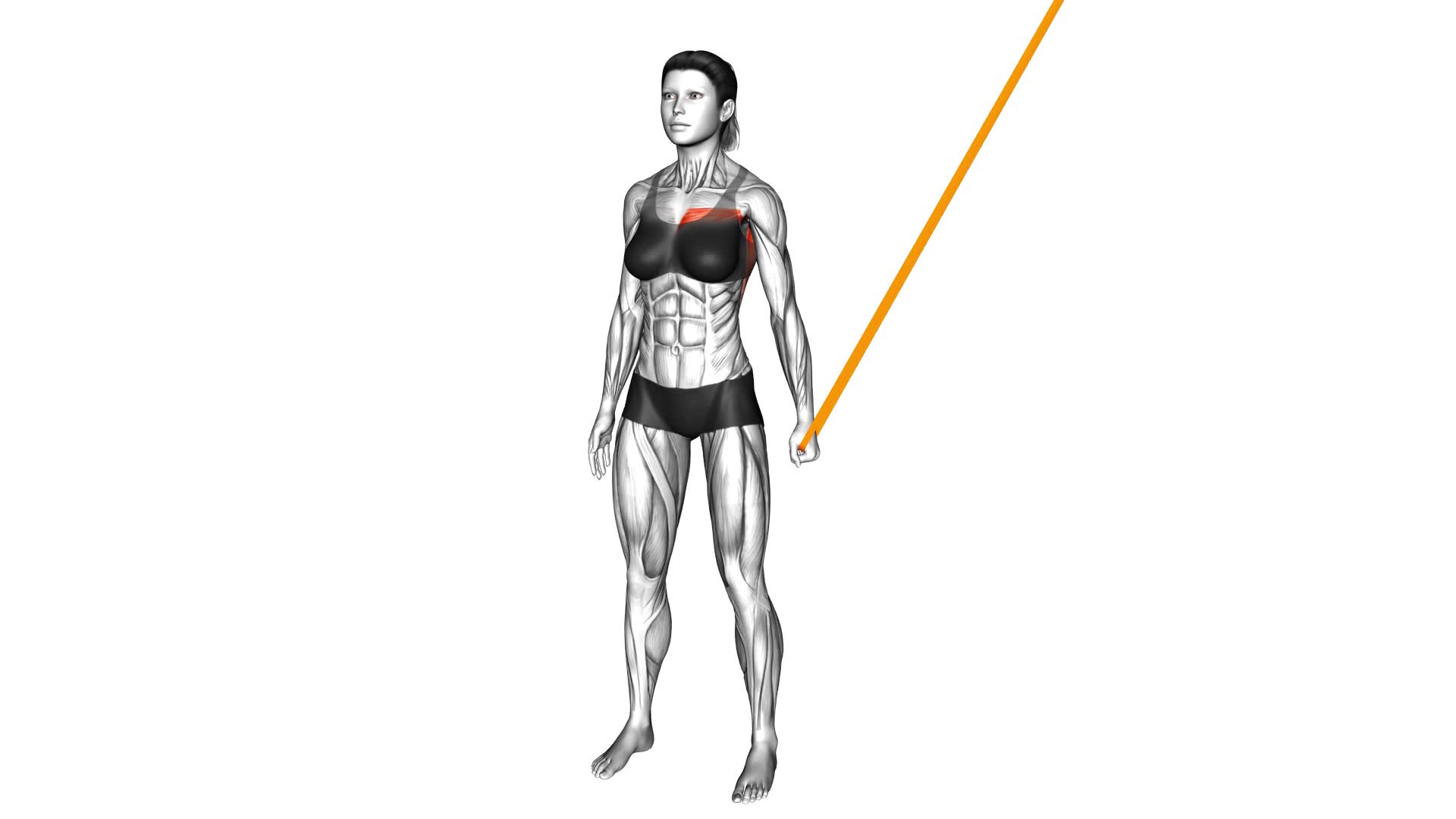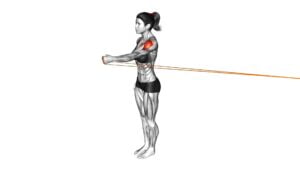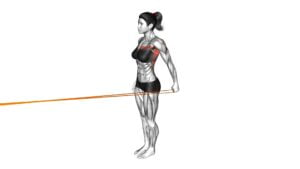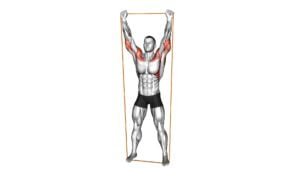Resistance Band Shoulder Adduction (female) – Video Exercise Guide & Tips

Looking to strengthen your shoulders? Check out this video exercise guide for resistance band shoulder adduction. In just a few minutes, you'll learn proper form and technique, as well as tips for choosing the right resistance band for your fitness level.
Watch This Exercise Video
Plus, we'll cover common mistakes to avoid to ensure you get the most out of your shoulder adduction workout.
Ready to take your shoulder strength to the next level? Let's get started!
Key Takeaways
- Resistance band shoulder adduction increases shoulder strength and improves range of motion.
- Proper form and technique include attaching the band to a stationary object, keeping elbows slightly bent, and maintaining control throughout the entire range of motion.
- Choosing the right resistance band involves considering current strength, different types of bands, band material, and band length.
- Progression and variation can be achieved by increasing resistance, changing body position, experimenting with angles and ranges of motion, and incorporating other upper body exercises.
Benefits of Resistance Band Shoulder Adduction
The benefits of resistance band shoulder adduction include increased shoulder strength and improved range of motion. This exercise is particularly beneficial for individuals in physical therapy or those looking to strengthen their shoulders.
Resistance band shoulder adduction targets the muscles in the shoulder, helping to build strength and stability. By regularly performing this exercise, you can enhance your overall shoulder function and prevent injuries.
The resistance band provides constant tension throughout the movement, working the muscles in a controlled manner. This helps to improve muscle strength and endurance.
Additionally, resistance band shoulder adduction promotes better range of motion in the shoulder joint. As you perform the exercise, you're actively stretching and contracting the shoulder muscles, allowing for increased flexibility and mobility. This is crucial in physical therapy settings, where patients often need to regain their full range of motion after an injury or surgery.
Proper Form and Technique for Shoulder Adduction
To ensure proper form and technique for shoulder adduction, focus on stability and control throughout the movement. This exercise targets the muscles in your shoulders, helping to strengthen and tone them. By performing the exercise correctly, you can maximize the benefits of shoulder adduction.
Start by attaching a resistance band to a stationary object at waist height. Stand with your feet shoulder-width apart and hold the band with both hands. Keep your elbows slightly bent and your shoulders relaxed. Begin the movement by bringing your hands together in front of your body, squeezing your shoulder blades together as you do so. Make sure to maintain control throughout the entire range of motion.
It's important to note that there are variations of shoulder adduction that you can incorporate into your workout routine. For instance, you can perform the exercise in a seated position or use different types of resistance bands to change the intensity. By trying different variations, you can target your shoulder muscles from different angles and challenge them in new ways.
Choosing the Right Resistance Band for Your Fitness Level
To choose the right resistance band for your fitness level, assess your strength and select a band with the appropriate level of resistance. Here are a few things to consider:
- Resistance Level: Determine your current strength level and choose a band that provides enough resistance to challenge your muscles without causing strain or injury. If you're a beginner, start with a lighter resistance band and gradually increase as your strength improves.
- Band Type: Resistance bands come in different types such as loop bands, tube bands, and figure-eight bands. Each type offers varying levels of resistance and versatility. Consider your specific needs and preferences when selecting a band type.
- Band Material: Resistance bands are made from different materials, including latex, fabric, and rubber. Each material has its own advantages and drawbacks. Latex bands are durable and provide consistent resistance, while fabric bands are softer and more comfortable on the skin.
- Band Length: The length of the resistance band can affect the range of motion and the exercises you can perform. Longer bands offer more flexibility, while shorter bands provide more resistance. Choose a band length that suits your workout goals and the exercises you plan to do.
By carefully considering these factors, you can choose a resistance band that's suitable for your fitness level and specific needs.
Remember to always consult with a fitness professional or trainer for guidance on incorporating resistance band exercises into your strength training routine.
Progression and Variation of the Shoulder Adduction Exercise
As you progress in your resistance band training, you can introduce variations to the shoulder adduction exercise to continue challenging your muscles and improving your strength.
There are several progression techniques you can incorporate to take your shoulder adduction exercise to the next level.
One way to progress the shoulder adduction exercise is by increasing the resistance of the resistance band. You can do this by using a band with higher tension or by doubling up on the bands for added resistance. This will require your muscles to work harder and help build even more strength.
Another progression technique is to change your body position. Instead of performing the exercise in a seated position, you can try standing or kneeling to engage different muscles and challenge your stability. You can also experiment with different angles and ranges of motion to target specific areas of the shoulder.
For those looking for advanced variations, you can try performing the shoulder adduction exercise with one arm at a time. This will further challenge your muscles and require greater stabilization. You can also incorporate other upper body exercises, such as bicep curls or overhead presses, while performing the shoulder adduction exercise to create a more complex movement pattern.
Remember to always maintain proper form and technique when performing these advanced variations. Start with lighter resistance or modifications if needed, and gradually increase the difficulty as your strength improves.
Common Mistakes to Avoid During Shoulder Adduction
Avoiding common mistakes is crucial when performing shoulder adduction exercises. To ensure that you're using the correct shoulder adduction technique and avoiding any potential errors, here are some common mistakes to be aware of:
- Using too much resistance: It's important to start with a resistance band that's appropriate for your current strength level. Using too much resistance can lead to improper form and increase the risk of injury.
- Hunching your shoulders: Keep your shoulders relaxed and avoid hunching them up towards your ears during the exercise. This ensures that the focus remains on the targeted muscles and reduces the strain on your neck and upper back.
- Rushing through the movement: Take your time and perform the shoulder adduction exercise with control. Rushing through the movement can compromise your form and decrease the effectiveness of the exercise.
- Neglecting proper posture: Maintain a good posture throughout the exercise by keeping your spine straight and your core engaged. This helps to stabilize your body and maximize the benefits of the shoulder adduction exercise.
Frequently Asked Questions
How Many Sets and Repetitions Should I Perform for the Resistance Band Shoulder Adduction Exercise?
For the resistance band shoulder adduction exercise, you should aim to perform 3 sets of 12 to 15 repetitions.
This exercise is great for strengthening the muscles in your shoulders and improving your posture.
To ensure proper form, stand with your feet hip-width apart and hold the resistance band at chest height.
Slowly bring your arms together in front of your body, squeezing your shoulder blades together.
Remember to keep your core engaged and maintain a controlled movement throughout.
Can I Perform the Resistance Band Shoulder Adduction Exercise if I Have a Shoulder Injury?
Yes, you can modify the resistance band shoulder adduction exercise if you have a shoulder injury. It's important to prioritize your safety and avoid aggravating your injury.
Consult with a healthcare professional or a certified trainer to learn proper modifications that suit your specific condition.
Resistance band exercises offer numerous benefits, such as improving shoulder stability and strengthening the surrounding muscles.
Are There Any Modifications or Alternative Exercises for Individuals Who Don't Have Access to a Resistance Band?
If you don't have a resistance band, there are alternative exercises you can try for shoulder adduction.
One option is the dumbbell shoulder adduction exercise, where you hold a dumbbell in one hand and bring it across your body towards the opposite hip.
Another modification is the cable machine shoulder adduction exercise, where you use a cable machine and a handle attachment to perform the movement.
These alternatives can help you work the same muscles without the need for a resistance band.
Is It Necessary to Warm up Before Performing the Resistance Band Shoulder Adduction Exercise?
Before performing the resistance band shoulder adduction exercise, it's important to warm up. Warming up helps increase blood flow to your muscles and prepares them for the upcoming activity. It also reduces the risk of injury.
Additionally, maintaining proper form is crucial in resistance band exercises to get the full benefits and avoid strain. So, take a few minutes to warm up and focus on your form to maximize the effectiveness of the shoulder adduction exercise.
How Long Does It Usually Take to See Results From Regularly Performing the Resistance Band Shoulder Adduction Exercise?
Regularly performing the resistance band shoulder adduction exercise can yield results within a few weeks. This exercise targets the muscles in your shoulders, helping to improve strength and stability.
By consistently incorporating this exercise into your routine, you can expect to see increased shoulder mobility and improved posture. Remember to avoid common mistakes such as using too much resistance or improper form, as this can hinder progress.
Stay committed and you'll start seeing the benefits in no time.
Conclusion
In conclusion, resistance band shoulder adduction is a beneficial exercise for strengthening the shoulder muscles.
It's important to maintain proper form and choose the right resistance band for your fitness level.
Progression and variation of the exercise can help challenge your muscles and prevent plateauing.
Be mindful of common mistakes to avoid during shoulder adduction to ensure a safe and effective workout.
Incorporating this exercise into your routine can help improve shoulder strength and stability.

Author
Years ago, the spark of my life’s passion ignited in my mind the moment I stepped into the local gym for the first time. The inaugural bead of perspiration, the initial endeavor, the very first surge of endorphins, and a sense of pride that washed over me post-workout marked the beginning of my deep-seated interest in strength sports, fitness, and sports nutrition. This very curiosity blossomed rapidly into a profound fascination, propelling me to earn a Master’s degree in Physical Education from the Academy of Physical Education in Krakow, followed by a Sports Manager diploma from the Jagiellonian University. My journey of growth led me to gain more specialized qualifications, such as being a certified personal trainer with a focus on sports dietetics, a lifeguard, and an instructor for wellness and corrective gymnastics. Theoretical knowledge paired seamlessly with practical experience, reinforcing my belief that the transformation of individuals under my guidance was also a reflection of my personal growth. This belief holds true even today. Each day, I strive to push the boundaries and explore new realms. These realms gently elevate me to greater heights. The unique combination of passion for my field and the continuous quest for growth fuels my drive to break new ground.







